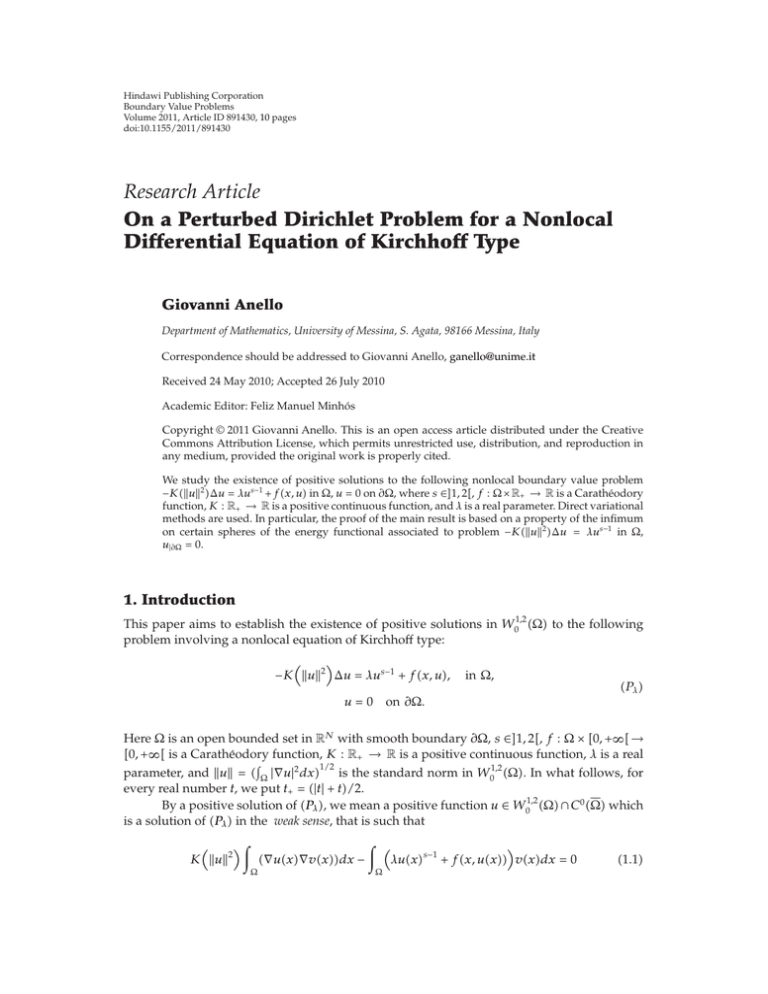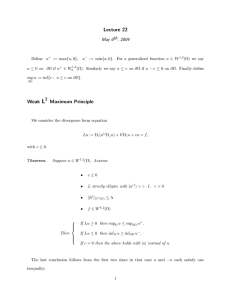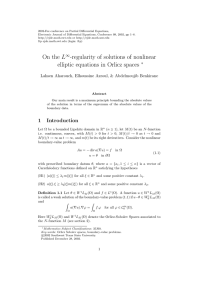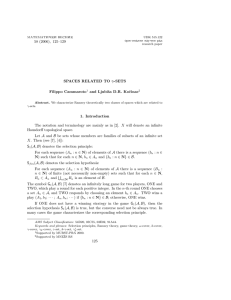Document 10841877
advertisement

Hindawi Publishing Corporation
Boundary Value Problems
Volume 2011, Article ID 891430, 10 pages
doi:10.1155/2011/891430
Research Article
On a Perturbed Dirichlet Problem for a Nonlocal
Differential Equation of Kirchhoff Type
Giovanni Anello
Department of Mathematics, University of Messina, S. Agata, 98166 Messina, Italy
Correspondence should be addressed to Giovanni Anello, ganello@unime.it
Received 24 May 2010; Accepted 26 July 2010
Academic Editor: Feliz Manuel Minhós
Copyright q 2011 Giovanni Anello. This is an open access article distributed under the Creative
Commons Attribution License, which permits unrestricted use, distribution, and reproduction in
any medium, provided the original work is properly cited.
We study the existence of positive solutions to the following nonlocal boundary value problem
−Ku2 Δu λus−1 fx, u in Ω, u 0 on ∂Ω, where s ∈1, 2, f : Ω × R → R is a Carathéodory
function, K : R → R is a positive continuous function, and λ is a real parameter. Direct variational
methods are used. In particular, the proof of the main result is based on a property of the infimum
on certain spheres of the energy functional associated to problem −Ku2 Δu λus−1 in Ω,
u|∂Ω 0.
1. Introduction
This paper aims to establish the existence of positive solutions in W01,2 Ω to the following
problem involving a nonlocal equation of Kirchhoff type:
−K u2 Δu λus−1 fx, u,
u0
in Ω,
Pλ on ∂Ω.
Here Ω is an open bounded set in RN with smooth boundary ∂Ω, s ∈1, 2, f : Ω × 0, ∞ →
0, ∞ is a Carathéodory function, K : R → R is a positive continuous function, λ is a real
1/2
parameter, and u Ω |∇u|2 dx is the standard norm in W01,2 Ω. In what follows, for
every real number t, we put t |t| t/2.
By a positive solution of Pλ , we mean a positive function u ∈ W01,2 Ω ∩ C0 Ω which
is a solution of Pλ in the weak sense, that is such that
2
K u
Ω
∇ux∇vxdx −
Ω
λuxs−1 fx, ux vxdx 0
1.1
2
Boundary Value Problems
for all v ∈ W01,2 Ω. Thus, the weak solutions of Pλ are exactly the positive critical points of
the associated energy functional
Iu u2
0
Kτdτ −
s−1
Ω
λu x
ux
fx, tdt dx,
0
u ∈ W01,2 Ω.
1.2
When Kt a bt a, b > 0, the equation involved in problem Pλ is the stationary
analogue of the well-known equation proposed by Kirchhoff in 1. This is one of the
motivations why problems like Pλ were studied by several authors beginning from the
seminal paper of Lions 2. In particular, among the most recent papers, we cite 3–7 and
refer the reader to the references therein for a more complete overview on this topic.
The case λ 0 was considered in 3 and 4, where the existence of at least
one positive solution is established under various hypotheses on f. In particular, in 3
the nonlinearity f is supposed to satisfy the well-known Ambrosetti-Rabinowitz growth
condition; in 4 f satisfies certain growth conditions at 0 and ∞, and fx, t/t is
nondecreasing on 0, ∞ for all x ∈ Ω. Critical point theory and minimax methods are
used in 3 and 4. For Kt a bt and λ 0, the existence of a nontrivial solution as
well as multiple solutions for problem Pλ is established in 5 and 7 by using critical
point theory and invariant sets of descent flow. In these papers, the nonlinearity f is again
satisfying suitable growth conditions at 0 and ∞. Finally, in 6, where the nonlinearity
is replaced by a more general hx, t and the nonlinearity f is multiplied by a positive
ts−1
parameter μ, the existence of at least three solutions for all λ belonging to a suitable interval
depending on h and K and for all μ small enough with upper bound depending on λ is
established see 6, Theorem 1. However, we note that the nonlinearity ts−1
does not meet
the conditions required in 6. In particular, condition a5 of 6, Theorem 1 is not satisfied
by ts−1
. Moreover, in 6 the nonlinearity f is required to satisfy a subcritical growth at ∞
and no other condition.
Our aim is to study the existence of positive solution to problem Pλ , where, unlike
previous existence results and, in particular, those of the aforementioned papers, no growth
condition is required on f. Indeed, we only require that on a certain interval 0, C the
function fx, · is bounded from above by a suitable constant a, uniformly in x ∈ Ω.
Moreover, we also provide a localization of the solution by showing that for all r > 0 we
can choose the constant a in such way that there exists a solution to Pλ whose distance
in W01,2 Ω from the unique solution of the unperturbed problem that is problem Pλ with
f 0 is less than r.
2. Results
Our first main result gives some conditions in order that the energy functional associated to
the unperturbed problem Pλ has a unique global minimum.
Theorem 2.1. Let s ∈1, 2 and λ > 0. Let K : 0, ∞ → R be a continuous function satisfying the
following conditions:
a1 inft≥0 Kt > 0;
t
a2 the function t → 1/2 0 Kτdτ − 1/sKtt is strictly monotone in 0, ∞;
t
a3 lim inft → ∞ t−2α 0 Kτdτ > 0 for some α ∈s/2, 1.
Boundary Value Problems
3
Then, the functional
Ψu 1
2
u2
Kτdτ −
0
λ
s
Ω
us dx,
u ∈ W01,2 Ω
2.1
admits a unique global minimum on W01,2 Ω.
Proof. From condition a3 we find positive constants C1 , C2 such that
1
2
u2
for every u ∈ W01,2 Ω.
Kτdτ ≥ C1 u2α − C2 ,
0
2.2
Therefore, by Sobolev embedding theorems, there exists a positive constant C3 such that
for every u ∈ W01,2 Ω.
Ψu ≥ C1 u2α − C2 − C3 us ,
2.3
Since s ∈0, 2α, from the previous inequality we obtain
lim Ψu ∞.
2.4
u → ∞
By standard results, the functional
u ∈ W01,2 Ω −→
1
s
Ω
2.5
us dx
is of class C1 and sequentially weakly continuous, and the functional
u∈
W01,2 Ω
1
−→
2
u2
2.6
Kτdτ
0
is of class C1 and sequentially weakly lower semicontinuous. Then, in view of the coercivity
condition 2.4, the functional Ψ attains its global minimum on W01,2 Ω at some point u0 ∈
W01,2 Ω.
Now, let us to show that
inf Ψ < 0.
2.7
W01,2 Ω
Indeed, fix a nonzero and nonnegative function v ∈ C0∞ Ω, and put vε εv. We have
λεs
Ψεv ≤ ε max Ktv −
s
t∈0,ε2 v2 2
2
Ω
vs dx.
2.8
4
Boundary Value Problems
Hence, taking into account that s < 2α < 2, for ε small enough, one has Ψvε < 0. Thus,
inequality 2.7 holds.
At this point, we show that u0 is unique. To this end, let v0 ∈ W01,2 Ω be another global
minimum for Ψ. Since Ψ is a C1 functional with
∇u∇v dx −
us−1
Ψ
uv K u2
v dx
Ω
2.9
Ω
for all u, v ∈ W01,2 Ω, we have that Ψ
u0 Ψ
v0 0. Thus, u0 and v0 are weak solutions
of the following nonlocal problem:
−K u2 Δu λus−1
u0
in Ω,
2.10
on ∂Ω.
Moreover, in view of 2.7, u0 and v0 are nonzero. Therefore, from the Strong Maximum
Principle, u0 and v0 are positive in Ω as well. Now, it is well known that, for every μ > 0,
the problem
−Δu μus−1
,
u 0,
in Ω,
2.11
on ∂Ω.
admits a unique positive solution in W01,2 Ω see, e.g., 8, Lemma 3.3. Denote it by uμ . Then,
it is easy to realize that for every couple of positive parameters μ1 , μ2 , the functions uμ1 , uμ2
are related by the following identity:
uμ 1 μ1
μ2
1/s−1
2.12
uμ 2 .
From 2.12 and condition a1 , we infer that u0 and v0 are related by
⎛ ⎞1/s−1
K v0 2
⎜
⎟
v0 .
u0 ⎝ ⎠
2
K u0 2.13
Ψ
u0 u0 Ψ
v0 v0 0
2.14
Now, note that the identities
lead to
2
2
K u0 u0 λ
Ω
us0 dx,
2
2
K v0 v0 λ
Ω
v0s dx
2.15
Boundary Value Problems
5
which, in turn, imply that
1
Ψu0 2
1
Ψv0 2
u0 2
0
v0 2
0
1 Kτdτ − K u0 2 u0 2 ,
s
2.16
1 Kτdτ − K v0 2 v0 2 .
s
Now, since u0 and v0 are both global minima for Ψ, one has Ψu0 Ψv0 . It follows that
1
2
u0 2
0
1 1
Kτdτ − K u0 2 u0 2 s
2
v0 2
0
1 Kτdτ − K v0 2 v0 2 .
s
2.17
At this point, from condition a2 and 2.17, we infer that
K u0 2 K v0 2
2.18
which, in view of 2.13, clearly implies u0 v0 . This concludes the proof.
Remark 2.2. Note that condition a2 is satisfied if, for instance, K is nondecreasing in 0, ∞
and so, in particular, if Kt a bt with a, b > 0.
From now on, whenever the function K satisfies the assumption of Theorem 2.1, we
denote by us the unique global minimum of the functional Ψ defined in 2.1. Moreover, for
every u ∈ W01,2 Ω and r > 0, we denote by Br u the closed ball in W01,2 Ω centered at u
with radius r. The next result shows that the global minimum us is strict in the sense that the
infimum of Ψ on every sphere centered in us is strictly greater than Ψus .
Theorem 2.3. Let K, λ, and s be as Theorem 2.1. Then, for every r > 0 one has
inf Ψus v > Ψus .
2.19
vr
Proof. Put Kt
1/2
t
0
Kτdτ for every t ≥ 0, and let r > 0. Assume, by contradiction, that
inf Ψus v Ψus .
2.20
vr
Then,
r 2 us 2 2us , v − λ
inf Ψ Ψus inf K
us vs dx .
vr
s Ω
W01,2 Ω
2.21
Now, it is easy to check that the functional
λ
2
2
Ju K r us 2us , u −
us us dx,
s Ω
u ∈ W01,2 Ω
2.22
6
Boundary Value Problems
is sequentially weakly continuous in W01,2 Ω. Moreover, by the Eberlein-Smulian Theorem,
every closed ball in W01,2 Ω is sequentially weakly compact. Consequently, J attains its global
minimum in Br 0, and
inf Ju inf Ju.
u≤r
ur
2.23
turns out to be a
Let v0 ∈ Br 0 be such that Jv0 infur Ju. From assumption a1 , K
strictly increasing function. Therefore, in view of 2.21, one has
v0 2 us 2 2us , u − λ us us dx Ψus v0 .
Ψus Jv0 ≥ K
s Ω
2.24
This inequality entails that us v0 is a global minimum for Ψ. Thus, thanks to Theorem 2.1, v0
is strictly increasing, from inequality 2.24,
must be identically 0. Using again the fact that K
we would get
Ψus Jv0 > Ψus v0 2.25
which is impossible.
Whenever the function K is as in Theorem 2.1, we put
μr inf Ψus v − Ψus vr
2.26
for every r > 0. Theorem 2.3 says that every μr is a positive number.
Before stating our existence result for problem Pλ , we have to recall the following
well-known Lemma which comes from 9, Theorems 8.16 and 8.30 and the regularity results
of 10.
Lemma 2.4. For every h ∈ L∞ Ω, denote by uh the (unique) solution of the problem
−Δu hx
u0
in Ω,
on ∂Ω.
2.27
Then, uh ∈ C1 Ω, and
maxΩ |uh | def
C0 < ∞,
h∈L∞ Ω\{0} hL∞ Ω
sup
where the constant C0 depends only on N, |Ω|.
2.28
Boundary Value Problems
7
Theorem 2.5 below guarantees, for every r > 0, the existence of at least one positive
solution ur for problem Pλ whose distance from us is less than r provided that the
perturbation term f is sufficiently small in Ω × 0, C with
0 C>C
def
λC0
M
1/2−s
.
2.29
Here C0 is the constant defined in Lemma 2.4 and M inft≥0 Kt > 0. Note that no growth
condition is required on f.
0 . Then, for every
Theorem 2.5. Let K, λ, and s be as in Theorem 2.3. Moreover, fix any C > C
r > 0, there exists a positive constant ar such that for every Carathéodory function f : Ω × 0, ∞ →
0, ∞ satisfying
Cs−1 2−s 2−s μr
,
C − C0 ,
fx, t < ar min λ
γr
2−s
C
ess sup
x,t∈Ω×0,C
def
2.30
0
where μr is the constant defined in 2.26 and γ is the embedding constant of W01,2 Ω in L1 Ω,
problem Pλ admits at least a positive solution u ∈ W01,2 Ω ∩ C1 Ω such that ur − us < r.
0 . For every fixed r > 0 which, without loss of generality, we can suppose
Proof. Fix C > C
such that r ≤ us , let ar be the number defined in 2.30. Let f : Ω × 0, ∞ → 0, ∞ be a
Carathéodory function satisfying condition 2.30, and put
⎧
⎪
fx, 0,
⎪
⎪
⎨
fC x, t fx, t,
⎪
⎪
⎪
⎩
fx, C,
ifx, t ∈ Ω × −∞, 0,
ifx, t ∈ Ω × 0, C,
2.31
ifx, t ∈ Ω × C, ∞,
as well as
a ess sup
x,t∈Ω×0,C
fx, t.
2.32
8
Boundary Value Problems
ux
Moreover, for every u ∈ W01,2 Ω, put Φu Ω 0 fC x, tdtdx. By standard
results, the functional Φ is of class C1 in W01,2 Ω and sequentially weakly continuous. Now,
observe that thanks to 2.30, one has
sup Φus v − Φus sup
v≤r
us xvx
Ω
v≤r
≤ sup
us x
fC x, tdt dx
us x|vx|
v≤r
Ω
us x
≤ a sup
v≤r
Ω
fC x, tdt dx
2.33
|vx|dx < ar γr μr .
Then, we can fix a number
σ ∈ Ψus , Ψus μr
2.34
in such way that
supv≤r Φus v − Φus σ − Ψus < 1.
2.35
Applying 11, Theorem 2.1 to the restriction of the functionals Ψ and −Φ to the ball Br us , it
follows that the functional Ψ − Φ admits a global minimum on the set Br us ∩ Ψ−1 − ∞, σ.
Let us denote this latter by ur . Note that the particular choice of σ forces ur to be in the interior
of Br us . This means that ur is actually a local minimum for Ψ − Φ, and so Ψ − Φ
ur 0.
In other words, ur is a weak solution of problem Pλ with fC in place of f. Moreover, since
r ≤ us and us − ur < r, it follows that ur is nonzero. Then, by the Strong Maximum
Principle, ur is positive in Ω, and, by 10, ur ∈ C1 Ω as well. To finish the proof is now
suffice to show that
max u ≤ C.
2.36
max u > C.
2.37
Ω
Arguing by contradiction, assume that
Ω
From Lemma 2.4 and condition 2.30 we have
C0
s−1
max u ≤ λmax u ar .
Ω
Ω
K u2
2.38
Boundary Value Problems
9
Therefore, using 2.30 and recalling the notation M inft≥0 Kt > 0, one has
max u
Ω
2−s
C0
≤
M
λ
ar
maxΩ us−1
C0
ar
≤
λ s−1 ≤ C2−s ,
M
C
2.39
that is absurd. The proof is now complete.
Remarks 2.6. To satisfy assumption 2.30 of Theorem 2.5, it is clearly useful to know some
lower estimation of ar . First of all, we observe that by standard comparison results, it is easily
seen that
C0 max u0 x,
2.40
x∈Ω
where u0 is the unique positive solution of the problem
−Δu 1, in Ω,
u 0, on ∂Ω.
2.41
When Ω is a ball of radius R > 0 centered at x0 ∈ RN , then u0 x 1/2NR2 − |x − x0 |2 , and
so C0 R2 /2N. More difficult is obtaining an estimate from below of μr : if r > us , one has
inf Ψus v ≥
vr
1
λ
inf Ktr − us 2 − γss r s ,
2 t≥0
s
2.42
where γs is the embedding constant of Ls Ω in W01,2 Ω. Therefore, μr grows as r 2 at ∞. If
r ≤ us , it seems somewhat hard to find a lower bound for μr . However, with regard to this
question, it could be interesting to study the behavior of μr on varying of the parameter λ for
every fixed r > 0. For instance, how does μr behave as λ → ∞? Another question that could
be interesting to investigate is finding the exact value of μr at least for some particular value
of r for instance r us even in the case of K ≡ 1.
References
1 G. Kirchhoff, Mechanik, Teubner, Leipzig, Germany, 1883.
2 J.-L. Lions, “On some questions in boundary value problems of mathematical physics,” in
Contemporary Developments in Continuum Mechanics and Partial Differential Equations, G. M. de la Penha
and L. A. J. Medeiros, Eds., vol. 30 of North-Holland Mathematics Studies, pp. 284–346, North-Holland,
Amsterdam, The Netherlands, 1978.
3 C. O. Alves, F. J. S. A. Corrêa, and T. F. Ma, “Positive solutions for a quasilinear elliptic equation of
Kirchhoff type,” Computers & Mathematics with Applications, vol. 49, no. 1, pp. 85–93, 2005.
4 A. Bensedik and M. Bouchekif, “On an elliptic equation of Kirchhoff-type with a potential
asymptotically linear at infinity,” Mathematical and Computer Modelling, vol. 49, no. 5-6, pp. 1089–1096,
2009.
5 A. Mao and Z. Zhang, “Sign-changing and multiple solutions of Kirchhoff type problems without the
P.S. condition,” Nonlinear Analysis: Theory, Methods & Applications, vol. 70, no. 3, pp. 1275–1287, 2009.
6 B. Ricceri, “On an elliptic Kirchhoff-type problem depending on two parameters,” Journal of Global
Optimization, vol. 46, no. 4, pp. 543–549, 2010.
10
Boundary Value Problems
7 Y. Yang and J. Zhang, “Positive and negative solutions of a class of nonlocal problems,” Nonlinear
Analysis: Theory, Methods & Applications, vol. 122, no. 1, pp. 25–30, 2010.
8 A. Ambrosetti, H. Brezis, and G. Cerami, “Combined effects of concave and convex nonlinearities in
some elliptic problems,” Journal of Functional Analysis, vol. 122, no. 2, pp. 519–543, 1994.
9 D. Gilbarg and N. S. Trudinger, Elliptic Partial Differential Equations of Second Order, vol. 22, Springer,
Berlin, Germany, 1977.
10 E. DiBenedetto, “C1α local regularity of weak solutions of degenerate elliptic equations,” Nonlinear
Analysis: Theory, Methods & Applications, vol. 7, no. 8, pp. 827–850, 1983.
11 B. Ricceri, “A general variational principle and some of its applications,” Journal of Computational and
Applied Mathematics, vol. 113, no. 1-2, pp. 401–410, 2000.




